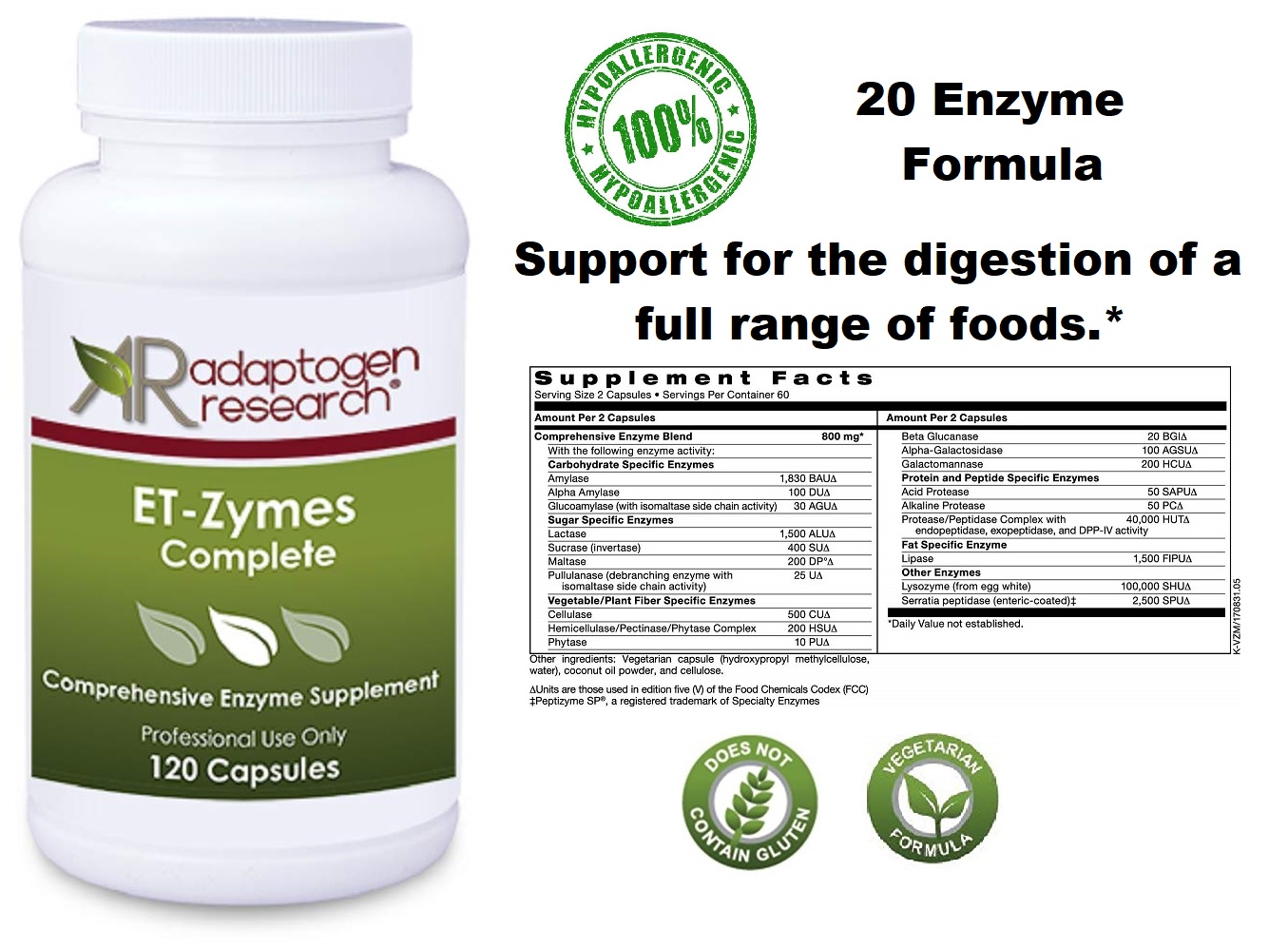Recent Posts
- » How to order Designs for Health products
- » Allergy Season Support . By day 2 the sniffles, sneezing and watery eyes stop.
- » Unique Combination of Three Curcuminoids
- » Vitamin C is required for immune system to function efficiently
- » Omnivits Bergamot Plus for Cardiovascular and Blood Sugar Support.
Blog - enzymes complex
Multi-enzyme supplement for extensive digestive support. How digestive enzymes work?
Posted by ProVitaMart on Jul 2nd 2019
Digestive enzymes break down food macronutrients, such as proteins, carbohydrates, and fats into smaller molecules for absorption by the intestines. These enzymes are secreted by salivary glands (alpha-amylase and lingual lipase), the stomach (pepsinogen, gelatinase, and gastric lipase), the pancreas (alpha-amylase, lipase, trypsinogen, and chymotrysinogen), and the small bowel (disaccharidases, intestinal lipase, and erepsin protease). Digestive enzymes are also present in raw foods such as fresh fruits and vegetables. Enzymes in raw foods are thought to work synergistically with the body’s endogenous digestive enzymes to more completely digest food carbohydrates and other macronutrients. This action is lost, however, when foods are cooked or heat processed, as this destroys the natural catalytic activity of food digestive enzymes. 1
Enzyme supplementation supports healthy digestion and may therefore alleviate occasional abdominal discomfort, bloating, gas, indigestion, or loose stools while supporting nutrient absorption.† Incompletely digested food in the gut may putrefy and produce irritating substances that affect intestinal mucosal integrity and gut permeability, systemic immune function, and overall energy. Children with dyspepsia typically exhibit low activity of duodenal maltase-glucoamylase and/or disaccharidases.2 Supplementing the diet with microbialderived digestive enzymes can assist the complete digestion of food components, promote normal nutrient absorption, and reduce the number of large, immunologically active molecules that can leak through the intestinal mucosa lining if permeability is not optimal.†
How Enzymes work
Amylases (amylase, alpha-amylase, and glucoamylase) are glycoside hydrolases that cleave a-(1g4) glycosidic bonds. Amylases hydrolyze amylose and amylopectin found in starchy vegetables such as potatoes, corn, rice, and wheat as well as glycogen and other related carbohydrates.
Disaccharidases (lactase, sucrase/invertase, and maltase) are enzymes that primarily hydrolyze disaccharides into their component monosaccharides (single sugars). Disaccharidases are normally found in the small intestinal brush border and are critical for the final steps of carbohydrate digestion.3
Acid, alkaline, and neutral proteases are enzymes that hydrolyze proteins into smaller fragments known as polypeptides.
Peptidases are enzymes that break polypeptides down into their constituent amino acids. Absorption of the undigested proteins and polypeptides may trigger food hypersensitivities. Incomplete digestion of gluten and casein may result in the production of exorphin (exogenous opiate-like) polypeptides that have the capacity to cause or potentiate adverse neurological symptoms.
Protease/peptidase complex has endopeptidase, exopeptidase, and DPP-IV activity. DPP-IV activity is critical to the catabolic inactivation of exorphins, bioactive peptides derived from food proteins with morphine-like opioid effects.4 Exorphins derive primarily from the milk protein casein, gluten, and soy. The DPP-IV activity present in the protease/peptidase provides for complete digestion of proline-rich proteins and efficient breakdown of dietary exorphins.†
Serratia peptidase is a unique endopeptidase enzyme that supports healthy inflammatory response during occasional GI stress by protecting sensitive gastrointestinal tissue from irritation and breaking down extraneous fibrin, mucus, and other compounds that accumulate as a part of the body’s natural repair process.†
Pullulanase, together with glucoamylase, supplies the isomaltase activity lacking in fungal- and microbial-derived sucrases facilitating the complete breakdown of highly branched amylopectin starch molecules.
Cellulase denotes a family of enzymes that digest plant material and promote greater nutrient absorption. Phytase breaks down phytic acid, an anti-nutrient that would otherwise complex with dietary minerals and interfere with their absorption.†
Lipase converts dietary triglycerides (fats or lipids) into diglycerides, monoglycerides, fatty acids, and glycerol. Absorption of fatty acids is important for health, normal fat digestion and stool fat content, and absorption of fat-soluble nutrients such as vitamins A, D, E, and K.5-7 The lipase promotes healthy fat digestion and absorption of essential lipids and fat-soluble nutrients.†
Lysozyme is an enzyme found in tears, saliva, mucus, and breast milk. Lysozyme breaks down peptidoglycans found in bacterial cell walls especially those of Gram-positive bacteria.
ET-Zymes Complete by Adaptogen Research is a high-strength, comprehensive digestive enzyme formula that provides a wide range of microbial-derived enzymes to support and enhance digestive function.† ET-Zymes Complete capsules contain a broad spectrum of enzymes that facilitate more complete breakdown of proteins, polypeptides, starches, vegetable fiber, polysaccharides, disaccharides, and lipids (fats).† These advanced digestive enzyme formulas provide a wide array of enzymes active across a broad pH range including:
- Amylases (amylase, alpha-amylase, and glucoamylase)
- Disaccharidases (lactase, sucrase/invertase, and maltase)
- Acid, alkaline, and neutral proteases
- Protease/peptidase complex with endopeptidase, exopeptidase, and dipeptidyl peptidase-IV activities
- Serratia peptidas
- Pullulanase
- Cellulase
- Phytase
- Lipase
- Lysozyme
References
1. Vonk, HJ and Western, JRH. Comparative Biochemistry and Physiology of Enzymatic Digestion. London; Orlando: Academic Press, 1984.
2. Karnsakul, W, et al. Disaccharidase activities in dyspeptic children: biochemical and molecular investigations of maltase- glucoamylase activity. J Pediatr Gastroenterol Nutr 2002; 4:551-6.
3. Langman JM, Rowland R. Activity of duodenal disaccharidases in relation to normal and abnormal mucosal morphology. J Clin Pathol 1990;43:537-40.
4. Gorrell MD. Dipeptidyl peptidase IV and related enzymes in cell biology and liver disorders. Clin Sci (Lond) 2005;108:277-92.
5. Griffin SM, Alderson D, Farndon JR. Acid resistant lipase as replacement therapy in chronic pancreatic exocrine insufficiency: a study in dogs. Gut 1989;30:1012-5.
6. Layer P, Keller J. Lipase supplementation therapy: standards, alternatives, and perspectives. Pancreas 2003;26:1-7.
7. Schneider MU, Knoll-Ruzicka ML, Domschke S, Heptner G, Domschke W. Pancreatic enzyme replacement therapy: comparative effects of conventional and enteric-coated microspheric pancreatin and acid-stable fungal enzyme preparations on steatorrhea in chronic pancreatitis. Hepatogastroenterology 1985;32:97-102.
8. Chipman DM, Pollock JJ, Sharon N. Lysozyme-catalyzed hydrolysis and transglycosylation reactions of bacterial cell wall oligosaccharides. J Biol Chem 1968;243:487-96.
† These statements have not been evaluated by the Food and Drug Administration. This product is not intended to diagnose, treat, cure, or prevent any disease.
 Loading... Please wait...
Loading... Please wait...